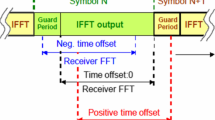Abstract
This paper proposes a simplified bit metric calculation method for high-order PSK signal with Gray-mapping. This method calculates the bit metric recursively by the symmetry of Gray code. Analysis and simulation results show that the proposed method can significantly reduce the computational complexity and maintain similar performance compared to ML and Max-Log bit metric. Additionally, this method generates bit metrics of PSK signals with different modulation order in the same way, so it can be applied to adaptive modulation system.
Similar content being viewed by others
References
Zehavi E. 8-PSK trellis codes for a Rayleigh channel. IEEE Trans Commun, 1992, 40: 873–884
Caire G, Taricco G, Biglieri E. Bit-interleaved coded modulation. IEEE Trans Inform Theory, 1998, 44: 927–946
802.11n. Enhancements for Higher Throughput. IEEE 802.11 WG.IEEE 802.11n/D1.0 Draft Amendment. 2006
802.16m. Draft IEEE 802.16m Evaluation Methodology. IEEE802.16m-07/037r1. 2007
LTE. Requirements for Evolved UTRA (E-UTRA) and Evolved UTRAN(E-UTRAN). 3GPP TR 25.913 v.7.3.0. 2006
Viterbi A J. An intuitive justification and a simplified implementation of the map decoder for convolutional codes. IEEE J Sel Area Comm, 1998, 16: 260–264
Tosato F, Bisaglia P. Simplified soft-output demapper for binary interleaved COFDM with application to HIPERLAN/2. In: Proceedings of IEEE International Conference on Communication. New York: IEEE, 2002. 664–668
Ghaffar R, Knopp R. Low complexity metrics for BICM SISO and MIMO systems. In: Proceedings of IEEE 71st Vehicular Technology Conference. Taipei: IEEE, 2010. 1–6
Hyun K, Yoon D. Bit metric generation for Gray coded QAM signals. IEE P-Commun, 2005, 152: 1134–1138
Yazdani R, Ardakani M. Efficient LLR calculation for non-binary modulations over fading channels. IEEE Trans Commun, 2011, 59: 1236–1241
Pan W, You X H. The recursive calculation method of bit soft output. J Electron Inf Technol, 2006, 28: 1111–1114
Xie Q L, Peng K W, Pan C Y, et al. Bit-interleaved LDPC coded modulation with iterative demapping and decoding. J Tsinghua Univ(Sci Tech), 2009, 49: 1201–1204
Zhao J, Zhang J Q. It confidence-based soft decision metric generation for QAM. J Electron Inf Technol, 2009, 31: 985–988
Nagaraj S. Symbol-level adaptive modulation for coded OFDM on block fading channels. IEEE Trans Commun, 2009, 57: 2872–2875
ETSI DVB-S2. Digital video broadcasting. ETSI EN 302 307. 2006
Author information
Authors and Affiliations
Corresponding author
Rights and permissions
About this article
Cite this article
Wang, L., Xu, D. & Zhang, X. A simplified bit metric calculation method for high-order PSK. Sci. China Inf. Sci. 56, 1–9 (2013). https://doi.org/10.1007/s11432-011-4469-3
Received:
Accepted:
Published:
Issue Date:
DOI: https://doi.org/10.1007/s11432-011-4469-3




